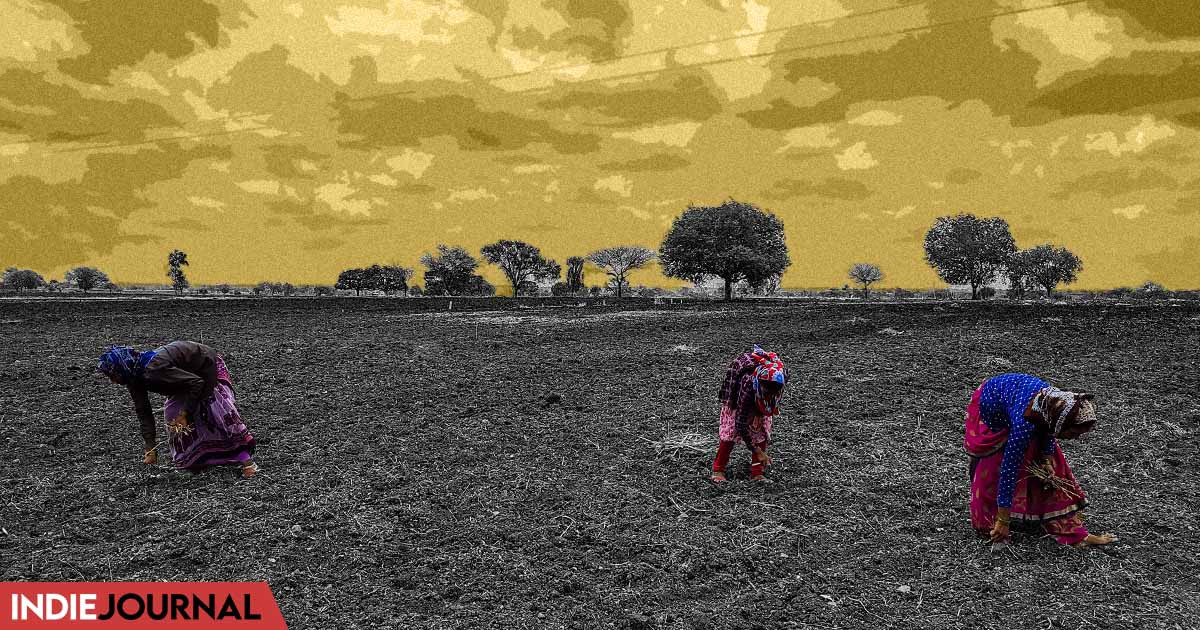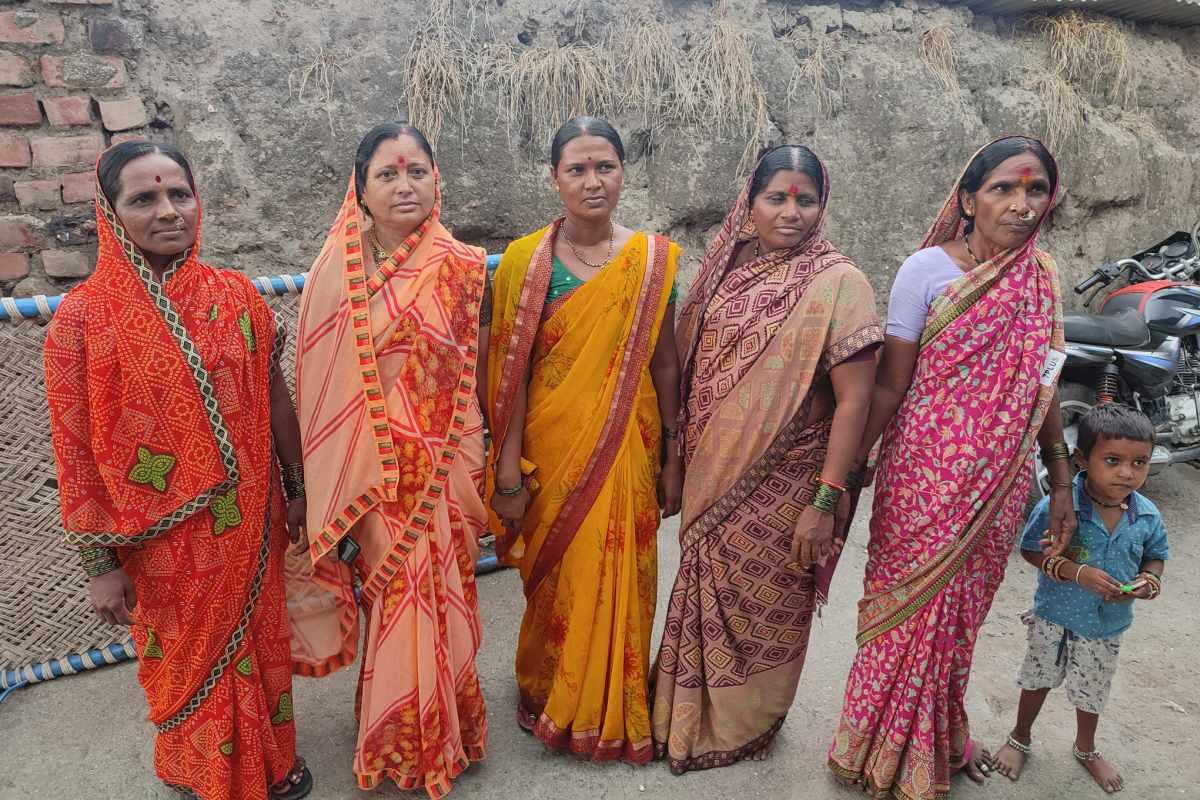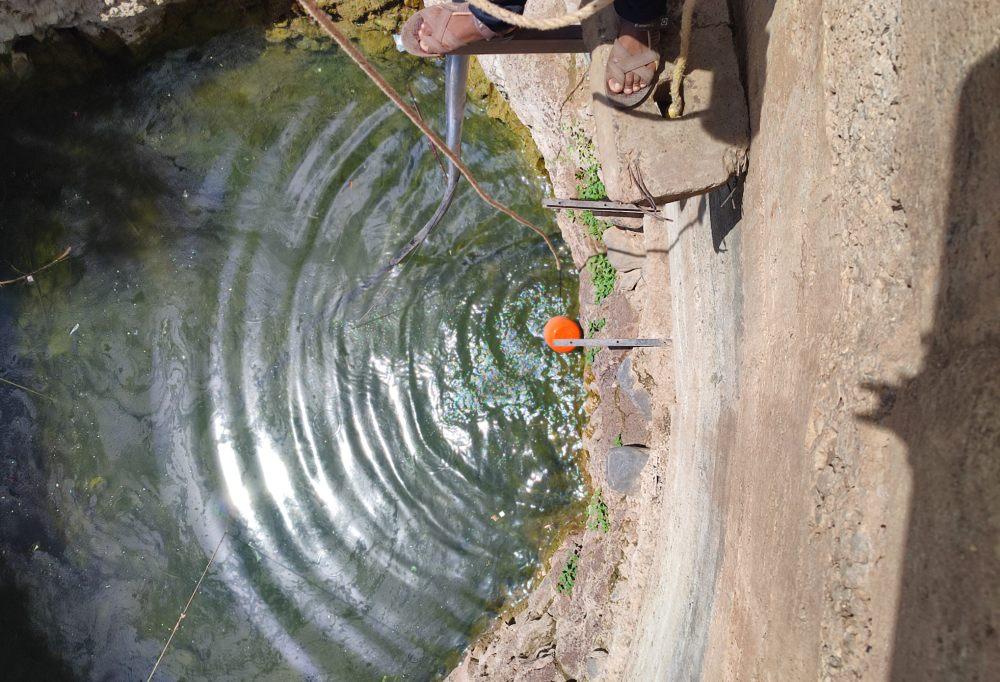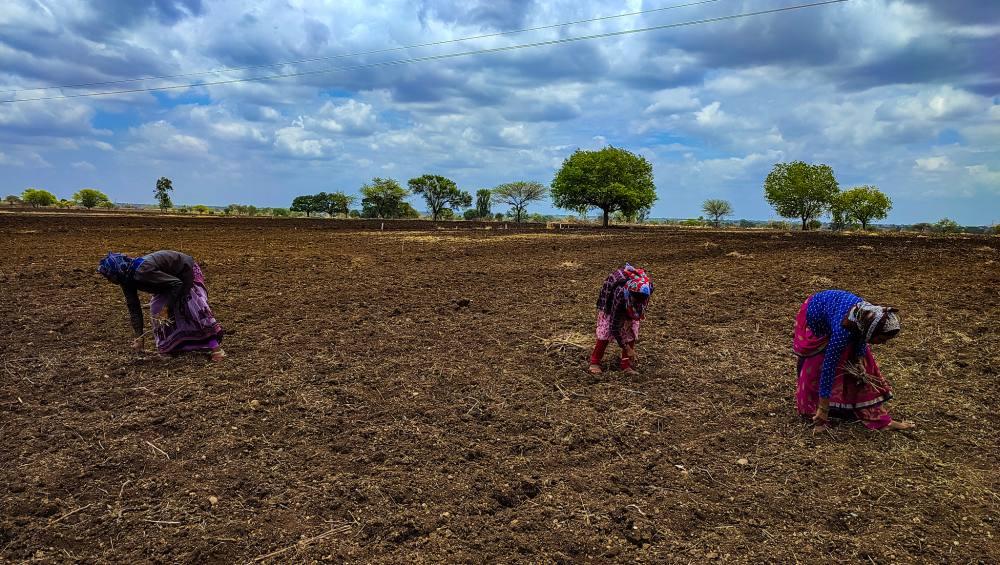India
Meet women farmers: The missing link in our climate action plans
Women farmers deserve space in the government's mitigation policies.

This report was produced through the grants provided under the Laadli Media Fellowship 2022.
Snehal Mutha | "Who likes to migrate? But now I am used to it! I don't have enough work in the village, wages are meager too. We live on loans for a couple of months. Pay off loans with migration work money. I don't like to relocate, but it has become a compulsion, or else my family would sleep hungry," says Chaya Male, 44, a farm labourer in Shivni village, Beed, Maharashtra.
Chaya hails from the Bhil community and has no ownership over farmland. She adds, "Husband does nothing when in the village. His only job is to get drunk and faint."
For the past 22 years, Chaya's life has been the same. Women who migrate for work have to slog even on returning to the village. The story is the same for women agricultural labourers in arid regions like Marathwada.
Over 250 Km away from Chaya's district, Manda Madne, a farmer, struggles to cope with the dry conditions of the region overlaying with climatic changes. She says, "Our region is dry, my husband and I decide crops accordingly. Pomegranate has been the number one yield of us. But the output was less for the past two years. Untimely rain destroyed fruits and trees."
Manda is from Dudhebavi Village in Maan taluka in Satara district. Her husband owns 23 acres of land.
Manda and Chaya both live in arid regions. Both are the victims of the existing geographical ecosystem. Somehow they had adapted to the prolonged droughts in the region, but are now exposed to climate change. The uncertain rainfall, temperature rise and water scarcity are destroying the agricultural fabric and affecting work opportunities in their villages. The work days decrease during the rainy and summer season, which forces them to leave their villages and work in poor conditions.
Typically, extreme weather conditions and climate change discourse has missed women farmers and the impact of the change on them. A woman plays a primary role in earning a livelihood - be it working in fields or migrating for work (Sugarcane cutters, brick kiln workers, construction workers). According to the Agriculture Census 2015, 88.46 percent of rural women in Maharashtra are employed in agriculture, the highest in the country.

Given the patriarchal norms, she is also the primary caregiver in the household. She is the first one to feel the brunt of weather extremity, yet the last one to be considered in climate resilience and mitigation policies and most likely to suffer from physical and psychological health problems, for example, exhaustion, anxiety, anemia and reproductive issues.
“Drought extremity could be felt in summers. In between, there is heavy rain, then a dry spell. Pressure on women increases as they have to deal with any extremity first. From availing water to cooking food for the household is their responsibility. The drought cycle is now changing and so are the drought indicators. Water unavailability and long queues are not the only indicators of droughts. We need to consider crop failure, borrowings for daily consumption, inter-state migration, farmer suicides and collateral damage on women as indicators too,” Ashok Tangde is a Social Activist in Beed.
A shift in rainfall and impact on agriculture
Arid regions routinely receive scanty rainfall, dry days are more and rainy days are few. In July this year, Marathawada has already received 55 percent of the total rain that the region gets overall in the four months of monsoon. Heavy rains in the first 15 days of July obliterated two lakhs 34 thousand hectares of agricultural land. Most of the Kharif crops like Soybean, Cotton, and Pulses were damaged. In 2021, drought-prone Marathwada received 1,041.5 mm of rainfall against its average of 679.5 in the monsoon season. Excess rainfall destroyed 25 lakh hectares of farmland in Marathwada in the last four months, as per the Business line report.
Dr Roxy Mathew Koll, a Climate Scientist at the Indian Institute of Tropical Meteorology (IIT) said, "Generally, we see a decline in total monsoon rainfall and an increase in heavy rains over the drought-prone regions. There has been a 15 percent decrease in the average summer monsoon rainfall (SMR) during 1950–2018. Today Marathwada receives 123 mm SMR less than earlier. The number of extreme rainfall events over Marathwada increased almost threefold during the same period."
The weather patterns are altering and becoming more unpredictable. It could exacerbate existing pressures as well as create new problems for women, especially those in rural areas.
For example, Pomegranate grows well under semi-arid conditions. The unusual pattern of rain spoiled fruit farming.
Manda says, "Drizzling infects fruit with Teliya (a fruit disease). For the past 5-8 years, this infection has been floating. Marrog is a more recent disease, it is lethal as it kills trees from roots. To get rid of teliya and marrog, heavy pesticides are used. Men's duty is over after spraying pesticides. Thereafter, we are in the field, working the whole day. It is extremely aggravating to work, we get headaches from breathing pesticides, eyes turn red, itchiness has become common."
Manda keeps a stock of painkillers on her. She takes one when headaches get unbearable. She says, "Every time going to the hospital is not feasible. For treatment, we have to visit Phaltan or a nearby town. For men, it is easy to stop by any government hospital and take an injection."
Bacillus Thuringiensis (BT) cotton is one of the most grown cash crops in Maharashtra. BT cotton is claimed to be a pest-resistant plant cotton variety and was introduced in India for better yields.

"Most women in BT cotton cultivations have complained of getting rashes. The women come in contact with the pink bollworm while plucking the cotton. They get rashes and feel itchy all over the body. Moreover nowadays, cotton is still getting infected with a variety of pests which we are unaware of," says Sita Bansod, Mayor of Kaij Nagar Panchayat in Beed district.
These instances show that a shift in the rain, a change in soil fabric brings a change in agriculture. Since women are involved in agriculture largely, climate change impacts them first. If it fails to rain or pours heavily, the labour of a woman increases.
During discussions on coping with extreme weather and current climate change, women expressed there was a time when seeds grew within one rainfall, hardly any other irrigation was required. Today, despite irrigation, the crop is failing. We are facing the side effects of incurred losses. The increase in fertilizer, groundwater depletion, inappropriate rainfall, change in crop patterns and poor soil quality is comparatively impacting women more given their role in the family system.
Gangotri Chanda, a youth environmental activist says, "Rural women workforce contribute to agriculture, poultry farming, etc. Yet, our policies on extreme weather conditions and climate change considering women are weak. One common thing in Mother nature and women is that both are treated as infinite resources and undervalued".
Rise in temperature
“Yanda uun jasta hota" (This year's temperature was higher) was the chorus voice of women living in different areas of drought-prone Beed, semi-arid region Maan (Satara) and Panshet (Pune). Beed had the hottest summer, with temperatures going up to 43 degrees Celsius, whereas Panshet, a heavy rainfall region, also suffered scorching heat.
"While working in the field, I felt dizzy and had a blackout. My husband brought me home. During summer, I saw more women feeling weak and dizzy. I carried a few women to the hospital, who had fainted while working in the scorching heat. We had to spend our wages for that day in hospital,” says Shobha Patole, 45, from Jadhavwadi village, Maan taluka, Satara.
Women's job roles in agriculture are time-consuming, so exposure to rising temperatures is high compared to men.
Pushpa Lokhare (45) from Wasad in Panshet, Pune, says, "Our heads would burn up from the heat. We often felt more exhaustion than on normal days and needed more frequent water breaks. I felt dehydrated and drinking too much water did not help either. It would give me stomachaches. Besides, eyes would get red and swollen at the end of the day."

Women felt tremors of high temperature at their workplace. The only precaution they took was wearing their husband’s shirt on the saree and carrying a piece of cloth on the head. A woman's husband who owned land was impacted lesser, but landless labourers faced the utmost burning heat. Taking water breaks at the expense of working hours was unaffordable. The International Labour Organisation (ILO) 2019 report titled 'Working on a Warmer Planet' warns that India is expected to lose 5.8 percent of working hours in 2030 due to heat stress i.e 34 million full-time jobs in 2030 due to heat stress.
Dr Parkhe, a Child specialist at the government hospital, Beed says, “During summers, women looked pale and exhaustive. Long working hours and scorching heat caused them constant mood swings, feeling agitated and unsatisfied. Heat affected them psychologically more."
The latest report by the Intergovernmental Panel on Climate Change (IPCC) shows the growing emphasis on addressing mental health challenges due to climate change, including anxiety and stress. Monitoring psychosocial impacts and access to mental health care from extreme weather events might help in minimising climate-related mental health issues.
Water scarcity and its impact on women
Vimal Munjal, said as she breathed heavily, “The day has just begun, but I am already exhausted. A lot of energy is required to pump water from the handpump; my throat has gone dry.” Vimal is among the women who come to fill water at the village handpump. She lives in the plain land of Shivni, Beed.
Vanita Barde, on the other hand, climbs down half a kilometre to an immediate well for water. She said, “We have a pipeline here, but water comes just once in 15 days. Tell me, for a family of five using 100 litres of water per day on average, how it will suffice. Vanita, 42, is a farm labourer in Shivni village, Beed.
Central Ground Water Board (CGWB) report pointed out that in the decadal (2010-2019) groundwater level condition of Maharashtra, the curve has gone down. A declining trend of more than 0.1 m was observed in isolated parts of Washim, Nagpur, Amravati, Latur, Aurangabad, Nashik, Ratnagiri, Buldhana and Yavatmal districts. The report suggests that less rainfall or over-exploitation is the reason for this decrease.
Chaya's daughter-in-law suffered a miscarriage in the eighth month while climbing back the hill with a 5-litre water vessel. Today she is pregnant with another child. Rural women spend most of their morningss and evenings fetching water for their homes. They usually need to make at least five to eight trips per day for water or pay for tanker or jar water (for drinking purpose).
Ujjawala Chole from Asoli in Dharur, Beed district says, “Tanker water is poured into the well, we draw water as and when required. This stored water is not good for health, we fall sick and many suffer from diarrhea, especially children."
Fetching water from the well is no cakewalk - walking long distances, getting into well at an appropriate height, pulling the heavy vessel up and carrying that home. This is repeated at least three times a day. These women often complain of headaches, backache and constant knee issues. It can put them at risk for cumulative damage to the spine and neck adding to chronic skeletal pain, of which elderly women who retired from fetching water complained. During the dry season, in water-stressed areas 30 percent or more of a woman's daily energy expenditure is spent harvesting water, as estimated in World Health Organisation (WHO) report, 2014.

Increasing the depth of borewell and tubewell is posing health issues to humankind. Reports state that more than 10,000 borewells are being sunk in Marathwada every month, even as water levels plunge to 800 feet or deeper. As it goes deeper, people are forced to drink biologically and toxicologically contaminated water.
Dr Guge from Beed says, “Women facing kidney stones are reported often, one of the reasons is drinking water. Borewell is the water source, most of the wells are dug 500-600 sg ft deep, making the water unfit to drink. The fluorides, sulfate and potassium levels go higher as you go deeper. The water becomes hard, causing kidney stones.”
Despite the rain, low precipitation and increased heat are complications created by climate change, that might result in drought. Several parts of Maharashtra are already arid. The increasing temperature escalates the water evaporation allowing the sun to heat the ground efficiently which might strain the water resources. The excess evaporation water resources in regions might further deplete groundwater levels and natural water bodies. It may further push women to travel long paths for water.
A study ‘Socio-economic vulnerability to climate change - Index development and mapping for districts in Maharashtra' conducted by the Indian Council of Agricultural Research (ICAR) finds 77 percent of Maharashtra’s cropped area vulnerable to climate change. Among 36 districts in Maharashtra, 24 are vulnerable to extreme weather events, erratic rainfall, rise in temperature and declining water table. The socio-economic vulnerability is high in Namdurbar, Buldhana, Beed, Jalna, Aurangabad, Hingoli, Parbhani, Nanded, Akola, Amravati and Washim districts.
Collateral damage from extreme weather conditions
During Kharif season, people work in their residential village. After sowing the rabi crops they migrate to work either in sugar factories, brick kiln factories or to cities like Pune-Mumbai for work. As the environment changes, it impacts the economy of that region. Failure of the crop and unemployment leads to migration. Most of the time, men migrate alone. The burden of family and farming falls on a woman's shoulders.
In Beed, migration takes place in couples. Children are left behind with elderly or elder siblings. Asha, a sugarcane cutter says, “Waking up at 4 am, cooking food, working long hours which our body doesn’t support is tiring. For the entire season, I suffer from abdominal pain. At the same time, kids are always on my mind. My elder one takes care of grandparents and her two siblings.”
The destination state has no proper housing conditions or sanitation in place. People migrate to sugarcane factories or brick kiln lands in tents or jugis with no proper sanitation facilities. Those migrating to Pune, Mumbai usually end up living in slums or at their relatives' homes. Migration not only poses poor living conditions for women but also causes an insecure environment for children and takes a toll on their education.
Asha’s daughter Priya has passed the 10th grade. She wants her to study, citing economic conditions she says she is unable to do so. Meanwhile, Priya insists her parents take her to the sugar factory. On asking why, she says, "Most of my time goes into filling water, cooking and feeding everyone. How to manage school? There is no time left to study. It is better to work in a factory instead.”
Teenage girls post 16 are usually married off here, for which parents cite security reasons. Migration means the risk of safety increases. So families find it easy to get their daughters married.

Arundhati Patil says, "Though education has improved, child marriage is increasing. The prevalence of sexual harassment is more. Besides once a girl child is married, they don't have to worry about her safety. Also from an economic lens, it is feasible. Women at both destination and origin districts suffer. Post sugarcane season, women slog on the farm and their husbands get drunk and fall somewhere."
Sanjay Dongre is a sugarcane cutter. He says, “Sugarcane cutting involves physically hard work, but pays good money. Financially it made me sound, I constructed my home and purchased land.”
Sanjay finds sugarcane cutting as an excellent source of interest-free loans and an economic alternative, but he is missing the exploitation of women in the entire process. Hysterectomy made the great buzz in Beed, the side effect is yet beneath it.
Shobha Patole, 45, from Jadhavwadi village, semi-arid region Maan taluka in Satara struggles to cope with the long-lasting effect of drought. A daily wage labourer, she says, "Farm work is so limited. During monsoon we work, otherwise take loans for daily consumption too.”
Her brother had to sell off land to get pipeline connections at his home. Shobha witnessed her neighbour attempting suicide due to a mountain of debt.
Marathawada and Vidarbha regions in the state have a high number of farmers' suicide in their accounts. The collateral damage is faced by a woman in the form of creditors' pressure for repayment of her husband's debts after his death by suicide. Their extended family blames the woman for the husband’s death. Lack of land ownership and knowledge of the outside world adds to her economic problems. These are a few damages to mention. The narrative keeps intensifying as you go to the remotest part of these regions.
The current extreme weather events and climate change are inevitable. Its impact on women is visible in terms of migration, debts, suicides and mental health issues. Yet, there are gaps in data, localised testimonies, conclusive research and expert observations. Data does not include climate variation impact on women farmers and labourers in the agricultural sector. The government policies on mitigation and adaptation efforts should systematically address gender-specific consequences of climate change in the areas. Chaya, Shobha, Vanita, Ujjawala, Manda and Vimal... all need space in the mitigation policies.






